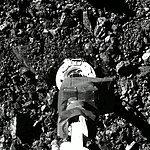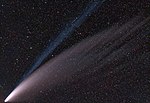astro.wikisort.org - Asteroid
2020 HS7 is a very small asteroid classified as a near-Earth object of the Earth-crossing Apollo group. When it was discovered by the Pan-STARRS 2 survey on 27 April 2020, the asteroid was initially calculated to have a 10% chance of impact with Earth before being ruled out by improved orbit determinations from additional observations.[6] Although there is now no risk of impact with Earth, it did make a close approach 42,700 kilometres (26,500 mi) from Earth on 28 April 2020, with a flyby speed of 15.6 kilometres per second (9.7 mi/s) relative to Earth.[3][7][5] The asteroid will not make any close encounters within 1 lunar distance (380,000 km; 240,000 mi) of Earth in the next 100 years.[3]
| Discovery[1][2] | |
|---|---|
| Discovered by | Pan-STARRS 2 |
| Discovery site | Haleakala Obs. |
| Discovery date | 27 April 2020 |
| Designations | |
MPC designation | 2020 HS7 |
Minor planet category | NEO · Apollo[3][1] |
| Orbital characteristics[3] | |
| Epoch 9 August 2022 (JD 2459800.5) | |
| Uncertainty parameter 6 | |
| Observation arc | 1 day |
| Aphelion | 2.904 AU |
| Perihelion | 0.793 AU |
Semi-major axis | 1.849 |
| Eccentricity | 0.5709 |
Orbital period (sidereal) | 2.51 yr (918 days) |
Mean anomaly | 308.988° |
Mean motion | 0° 23m 31.807s / day |
| Inclination | 4.732° |
Longitude of ascending node | 38.531° |
Argument of perihelion | 245.692° |
| Physical characteristics | |
| Dimensions | a/b = ≥1.04[4] |
Mean diameter | 4–8 m[5] |
Synodic rotation period | 2.9945±0.0002 s[4] 2.9938±0.0002 s[4] |
Absolute magnitude (H) | 29.10±0.36[3] |
Observations by Kiso Observatory in Nagano, Japan show that the asteroid rotates extremely rapidly with a rotation period of 3 seconds, making it the fastest-rotating asteroid known as of 2022[update].[4] No other near-Earth asteroid of similar size is known to have a rotation period shorter than 10 seconds, which could be attributed to the tangential component of the YORP effect accelerating their rotation far beyond this period.[4] The asteroid exhibits a very small light curve amplitude of 0.07 magnitudes, which either implies a nearly spherical shape or a pole-on rotation during observations.[4]
See also
- List of fast rotators (minor planets)
- List of asteroid close approaches to Earth in 2020
References
- "2020 HS7". Minor Planet Center. Retrieved 15 July 2022.
- "MPEC 2022-F48 : 2022 FD1". Minor Planet Electronic Circular. Minor Planet Center. 28 April 2020. Retrieved 15 July 2022.
- "JPL Small-Body Database Browser: (2020 HS7)" (2022-04-28 last obs.). Jet Propulsion Laboratory. Retrieved 29 July 2020.
- Beniyama, Jin; et al. (2022). "Video observations of tiny near-Earth objects with Tomo-e Gozen". Publications of the Astronomical Society of Japan. arXiv:2207.07071. doi:10.1093/pasj/psac043.
- Bartels, Meghan (5 May 2020). "Tiny asteroid's super-close Earth flyby shows planetary protection in action, scientists say". Space.com.
- "ESA space situational awareness 2020HS7". European Space Agency. Retrieved 29 July 2020.
- Malik, Tariq (28 April 2020). "Small asteroid zips safely by Earth just ahead of a larger space rock's flyby". Space.com.
External links
- 2020 HS7 at NeoDyS-2, Near Earth Objects—Dynamic Site
- 2020 HS7 at ESA–space situational awareness
- 2020 HS7 at the JPL Small-Body Database
Другой контент может иметь иную лицензию. Перед использованием материалов сайта WikiSort.org внимательно изучите правила лицензирования конкретных элементов наполнения сайта.
WikiSort.org - проект по пересортировке и дополнению контента Википедии


